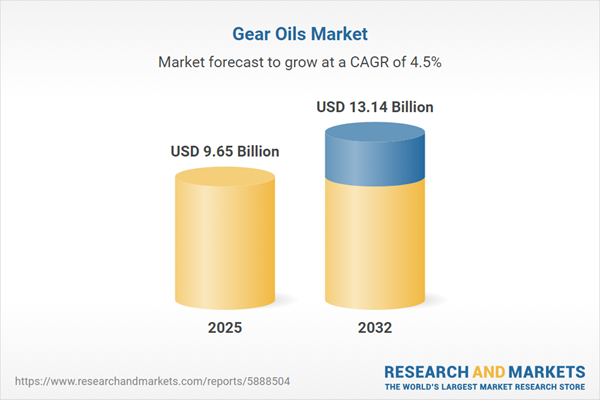Speak directly to the analyst to clarify any post sales queries you may have.
The gear oils market is evolving as companies respond to new regulatory demands, apply digital innovations, and revamp procurement to sustain competitiveness and compliance. Agility and robust supply chain strategies are essential for senior decision-makers in this shifting landscape.
Market Snapshot: Gear Oils Market Growth and Strategic Overview
The global gear oils market is projected to reach USD 9.65 billion by 2025, rising from USD 9.23 billion in 2024, at a compound annual growth rate (CAGR) of 4.50% through 2032. This market expansion is driven by the rising adoption of synthetic lubricants and the integration of digitalization, which supports operational efficiencies in both automotive and industrial applications. Enterprises are modifying procurement models to address regulatory changes, while new lubricant formulations enable enhanced performance and progress toward sustainability. Digital transformation continues to increase transparency and agility across supply chains, equipping organizations to respond to regulatory shifts and evolving customer needs.
Scope & Segmentation: Strategic Opportunities in the Gear Oils Market
This report provides essential market intelligence tailored for executive decision-makers, highlighting high-potential segments, regional priorities, and emerging lubrication technologies. The broad scope empowers leaders to identify growth areas and proactively manage supply and compliance risks within continuously changing international environments.
- Product Types: Mineral oils, advanced semi-synthetic lubricants, and specialty high-performance formulations such as alkylated naphthalene, diester, and polyalphaolefin align with both standard and specialized industrial operations.
- Applications: Gear oils are vital for commercial vehicles, passenger cars, two-wheelers, marine equipment, mining, and steel manufacturing machinery, ensuring seamless operation and protection of critical systems.
- Viscosity Grades: Available grades from SAE 75W-90 to 85W-140 address a spectrum of machinery requirements, supporting varying operational conditions and technical demands.
- End Users: Both original equipment manufacturers and aftermarket suppliers influence procurement preferences, regulatory focus, and product innovation velocity within the gear oils sector.
- Distribution Channels: Retail outlets, digital commerce platforms, and wholesale distributors enable diverse customer engagement and support localized procurement efficiencies.
- Regions: Distinct market approaches are required across North America, South America, Europe, Middle East & Africa, and Asia-Pacific, reflecting differing regulations and customer behaviors.
- Key Companies: Leading organizations such as Exxon Mobil Corporation, Royal Dutch Shell plc, BP p.l.c., Chevron Corporation, TotalEnergies SE, Fuchs Petrolub SE, Valvoline Inc., China Petroleum & Chemical Corporation, PetroChina Company Limited, and Idemitsu Kosan Co., Ltd. continue to invest in innovation and stronger supply networks.
Key Takeaways: Strategic Insights for Senior Leaders
- Synthetic base oils and advanced additives are extending equipment lifespans, simplifying maintenance strategies, and improving overall value for industrial supply chains.
- Sustainable gear oil offerings are focused on environmental compliance, enabling companies to keep pace with constant changes in regulations and customer mandates.
- Digital procurement and inventory management initiatives deliver greater operational visibility, minimize downtime, and foster more reliable sourcing for essential supply lines.
- Recent technology advancements ensure compatibility across both legacy systems and next-generation electrified drive trains, supporting broad transitions in end-user industries.
- Region-specific approaches enable organizations to remain agile, maintaining compliance and capitalizing on growth opportunities unique to each geographic market.
Tariff Impact: Navigating 2025 Policy Shifts
As new tariff changes approach in 2025, supply chain and procurement leaders are enhancing operational readiness and refining supplier collaborations. Establishing local blending operations near key demand centers reduces logistical complexities and supports regulatory compliance. Flexible supplier contracts and advanced inventory planning, including efficient cross-border logistics, play a strategic role in upholding market continuity and positioning during tariff transitions.
Methodology & Data Sources
This report is informed by structured interviews with senior experts in engineering, procurement, and distribution from leading industry companies. Findings are validated by subject matter authorities and cross-verified with current regulatory data to ensure actionable insights for decision-makers.
Why This Report Matters
- Enables leaders to align sourcing and operational models with regulatory and environmental requirements for sustained compliance and business continuity.
- Demonstrates the value of in-depth segment analysis in optimizing resource distribution and managing portfolio risks in the gear oils industry.
- Provides frameworks for adapting rapidly to trade policy and tariff changes, enhancing supply chain resilience and market flexibility.
Conclusion
This report equips senior leaders to advance innovation, achieve sustainability targets, and drive digital transformation as the global gear oils market continues its strategic evolution.
Additional Product Information:
- Purchase of this report includes 1 year online access with quarterly updates.
- This report can be updated on request. Please contact our Customer Experience team using the Ask a Question widget on our website.
Table of Contents
3. Executive Summary
4. Market Overview
7. Cumulative Impact of Artificial Intelligence 2025
Companies Mentioned
The companies profiled in this Gear Oils market report include:- Exxon Mobil Corporation
- Royal Dutch Shell PLC
- BP p.l.c.
- Chevron Corporation
- TotalEnergies SE
- Fuchs Petrolub SE
- Valvoline Inc.
- China Petroleum & Chemical Corporation
- PetroChina Company Limited
- Idemitsu Kosan Co., Ltd.
Table Information
| Report Attribute | Details |
|---|---|
| No. of Pages | 196 |
| Published | November 2025 |
| Forecast Period | 2025 - 2032 |
| Estimated Market Value ( USD | $ 9.65 Billion |
| Forecasted Market Value ( USD | $ 13.14 Billion |
| Compound Annual Growth Rate | 4.5% |
| Regions Covered | Global |
| No. of Companies Mentioned | 11 |









